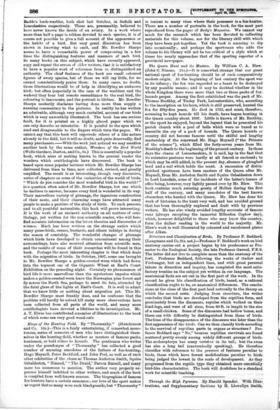Structure and Classification of Birds. By Professor F. Beddard. (Longmans
and Co. 21s. net.)—Professor F. Beddard's work on bird anatomy carries out a project begun by his predecessor as Pro. sector to the Zoological Society, the late Professor Garrod, F.R.S. The latter did not live to complete more than the anatomy of the fowl. Professor Beddard, following the works of Gadow and Fiirbunger, but on independent lines, and with great personal labour in dissection and inquiry, has completed the most satis- factory treatise on the subject yet written in our language. The anatomical facts are set out in the first part of the work. In the second he gives his classification of birds, based, as a rational classification ought to be, on anatomical differences. The conclu- sions at the close of the first part lead naturally to the theory on which the second rests. Judging from structure, the writer concludes that birds are developed from the reptilian form, and proximately from the dinosaurs, reptiles which walked on their hind-legs, and were of all sizes, from 60 ft. in length to the size of a small chicken. Some of the dinosaurs had hollow bones, and these can with difficulty be distinguished from those of birds. The time of the disappearance of the dinosaurs was later than the first appearance of the birds. Can we then classify birds according to the survival of reptilian parts in organs or structure ? Pro- fessor Beddard says "No," because reptilian survivals are found scattered pretty evenly among widely different groups of birds. The archteopteryx has many vertebrx in its tail; but the swan has also a long tail (anatomically speaking). He therefore classifies with reference to the presence of features peculiar to birds, those which have fewest modifications peculiar to birds being judged the lowest in the scale of development. As they progressed from the reptile type they obtained more essentially bird-like characteristics. The book will doubtless be a standard work for scientific teaching.






















































 Previous page
Previous page